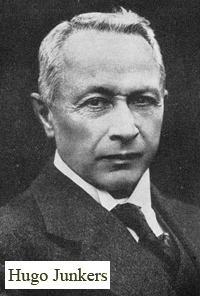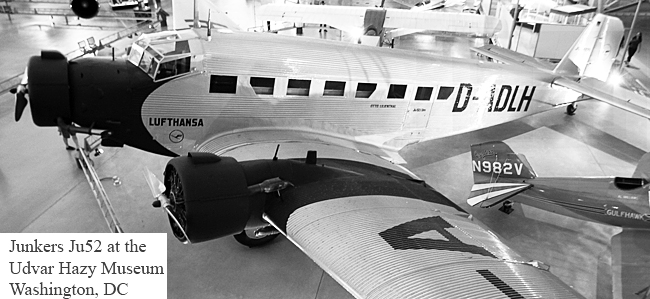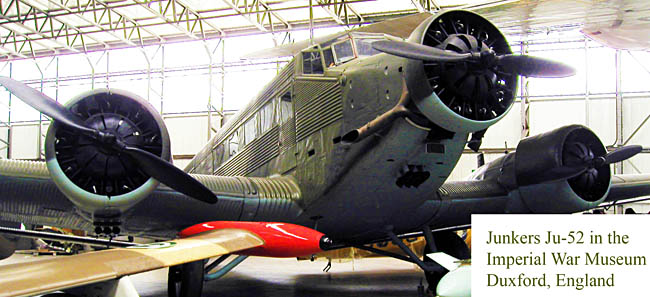Junkers Ju-52
Today, Hugo Junkers' famous airplane. The University of Houston's College of Engineering presents this series about the machines that make our civilization run, and the people whose ingenuity created them.
Here's a plane you've all seen in WW-II footage -- a low-wing German transport plane with corrugated metal skin, angular lines, two engines on the wings, and one more in the nose. It's the Junkers Ju-52 -- a sword made into a plowshare made into a sword.
 It traces back to 1915 when Hugo Junkers began work on the first practical all-metal airplane -- a single-wing fighter. The production model flew 126 miles-an-hour -- quite fast for those times. But it was too sluggish to be a fighter plane. People called it the Blechesel or Tin Donkey, and the Germans dropped it.
It traces back to 1915 when Hugo Junkers began work on the first practical all-metal airplane -- a single-wing fighter. The production model flew 126 miles-an-hour -- quite fast for those times. But it was too sluggish to be a fighter plane. People called it the Blechesel or Tin Donkey, and the Germans dropped it.
Still, Junkers had shown that airplanes could be made of metal instead of fabric, wood, and bamboo. And passenger planes had no need for the athleticism of fighter planes. Right after the Armistice, Junkers built a little single-engine, four-passenger airplane and sold over three hundred of them.
The first Ju-52 appeared in 1931, a bigger all-metal plane -- still only one engine. It was meant to haul freight. When it failed (and almost bankrupted the company) Junkers retrenched and built the 3-engine, 17-passenger version. It was another winner. As late as 1960, the last of them were flying in the Far East where they had to land on airstrips that were too rough for the DC-3.
The all-metal Ju-52 had corrugated duralumin skin like the old Ford and Fokker Trimotor passenger planes. But it was far ahead of them. What had begun as the Tin Donkey, was now affectionately called the Iron Aunt.

Then came the Nazis. Junkers, had been a genius engineer and the company's founder. Now an old man, he'd become a pacifist while his upper management had become NAZI party members. The company gave Hitler a Ju-52 to use in his campaign to become Chancellor. When Hitler took power, he nationalized the passenger service, Luft Hansa, and he put Junkers under house arrest. The Ju-52s were repainted with iron crosses and swastikas.

In the end, over 5400 Ju-52s were made in countless variations. They hauled passengers, cargo, and paratroops. Some were ski-planes, some bombers, some used for aerial medivac. This was the airplane that took Hitler to his secret meetings with Mussolini. It served as a Fascist bomber in Spain; it supplied Rommel's troops in North Africa; it ferried slave laborers, it tried to evacuate German wounded from the slaughter on the Eastern front.
But many served China in their war against Japan. As Americans captured them in different countries, they put them into service as C-79 cargo planes. The neutral Swiss and the Canadian Air force both flew them. Only eight are still flying, and we tend to look askance at this machine, once so emblematic of an Evil Empire.
It's a mute reminder that even a fine machine, made by a pacifist for a perfectly noble purpose, can nevertheless be used to implement the worst of human impulses.
I'm John Lienhard, at the University of Houston, where we are interested in the way inventive minds work.
H-H. Stapfer, H-J. Mau, G. Punka, D. Green, Junkers Ju 52. Aircraft Number 186 (Carrollton, TX: Squadron/Signal Publications, 2002).
The Hugo Junkers photo are courtesy of Wikimedia Commons. The two Ju-52 photos are by John Lienhard
See also the Wikipedia entries for Hugo Junkers, the Junkers J-1, and the Junkers Ju-52.
This episode was first aired on December 6, 2011